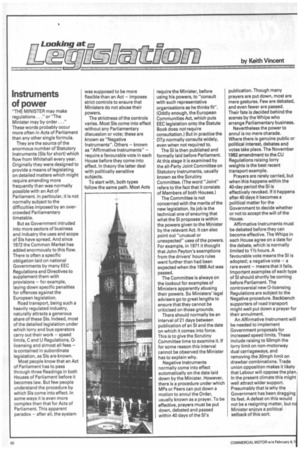Looking at L7 ___ by Keith Vincent
Page 62

If you've noticed an error in this article please click here to report it so we can fix it.
Instruments of power
"THE MINISTER may make regulations ..." or "The Minister may by order. ..." These words probably occur more often in Acts of Parliament than any other single formula.
They are the source of the enormous number of Statutory Instruments (Sls for short) which flow from Whitehall every year. Originally they were designed to provide a means of legislating on detailed matters which might require amending more frequently than was normally possible with an Act of Parliament. In particular, it is not normally subject to the difficulties imposed by an overcrowded Parliamentary timetable.
But as Government intruded into more sectors of business and industry the uses and scope of Sls have spread. And since 1972 the Common Market has added enormously to this flow. There is often a specific obligation laid on national Governments by many EEC Regulations and Directives to supplement them with provisions — for example, laying down specific penalties for offences against the European legislation.
Road transport, being such a heavily regulated industry, naturally attracts a generous share of these Sls. Indeed, most of the detailed legislation under which lorry and bus operators carry out their work — speed limits, C and U Regulations, 0licensing and almost all fees — is contained in subordinate legislation, as Sls are known.
Most people know that an Act of Parliament has to pass through three Readings in both Houses of Parliament before it becomes law. But few people understand the procedure by which Sls come into effect. In some ways it is even more complex than that for Acts of Parliament. This apparent paradox — after all, the system was supposed to be more flexible than an Act — imposes strict controls to ensure that Ministers do not abuse their powers.
The strictness of the controls varies. Most Sls come into effect without any Parliamentary discussion or vote; these are known as "Negative Instruments". Others — known as "Affirmative Instruments" — require a favourable vote in each House before they come into effect. In theory the latter deal with politically sensitive subjects.
To start with, both types follow the same path. Most Acts require the Minister, before using his powers, to "consult with such representative organisations as he thinks fit". (Oddly enough, the European Communities Act, which puts EEC legislation onto the Statute Book does not require consultation.) But in practice the DTp normally consults widely, even when not required to.
The SI is then published and formally laid before Parliament. At this stage it is examined by the all-Party Joint Committee on Statutory Instruments, usually known as the Scrutiny Committee. (The word "Joint" refers to the fact that it consists of Members of both Houses.) The Committee is not concerned with the merits of the new legislation. Its job is the technical one of ensuring that what the SI proposes is within the powers given to the Minister by the relevant Act. It can also point out "unusual or unexpected" uses of the powers. For example, in 1971 it thought that John Peyton's exemptions from the drivers' hours rules went further than had been expected when the 1968 Act was passed.
The Committee is always on the lookout for examples of Ministers apparently abusing their powers. So Ministers' legal advisers go to great lengths to ensure that they cannot be criticised on those grounds.
There should normally be an interval of 21 days between publication of an SI and the date on which it comes into force. This is to give the Scrutiny Committee time to examine it. If for some reason this interval cannot be observed the Minister has to explain why.
Negative Instruments normally come into effect automatically on the date laid down by the Minister. However, there is a procedure under which MPs or Peers can put down a motion to annul the Order, usually known as a prayer. To be effective, prayers must be put down, debated and passed within 40 days of the SI's publication. Though many prayers are put down, most are mere gestures. Few are debated, and even fewer are passed. Their fate is decided behind the scenes by the Whips who arrange Parliamentary business.
Nevertheless the power to annul is no mere charade.
Where there is genuine public or political interest, debates and votes take place. The November 1982 amendment to the CU Regulations raising lorry weights is the best recent transport example.
Prayers are rarely carried, but when this happens within the 40-day period the SI is effectively revoked. If it happens after 40 days it becomes a political matter for the Government to decide whether or not to accept the will of the House.
Affirmative Instruments must be debated before they can become effective. The Whips in each House agree on a date for the debate, which is normally limited to 11/2 hours. A favourable vote means the SI is adopted; a negative vote — a rare event — means that it fails. Important examples of each type of SI should shortly be coming before Parliament. The controversial new 0-licensing Regulations are subject to the Negative procedure. Backbench supporters of road transport might well put down a prayer for their annulment.
An Affirmative Instrument will be needed to implement Government proposals for increased speed limits. These include raising to 50mph the lorry limit on non-motorway dual carriageways, and removing the 30mph limit on drawbar combinations. Trade union opposition makes it likely that Labour will oppose the plan. In the present climate this might well attract wider support. Presumably that is why the Government has been dragging its feet. A defeat on this would not be a resigning matter, but nc Minister enjoys a political setback of this sort.
































































































